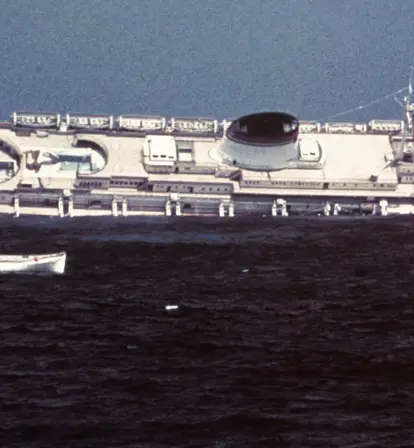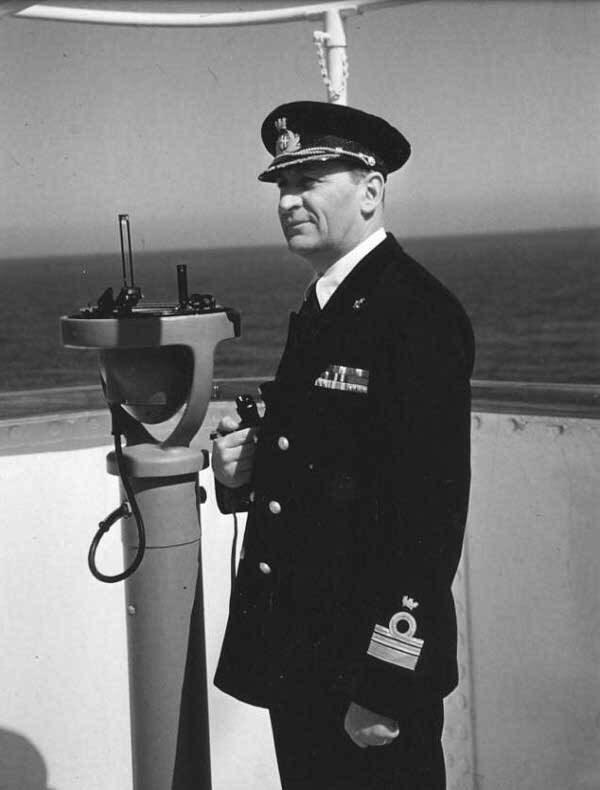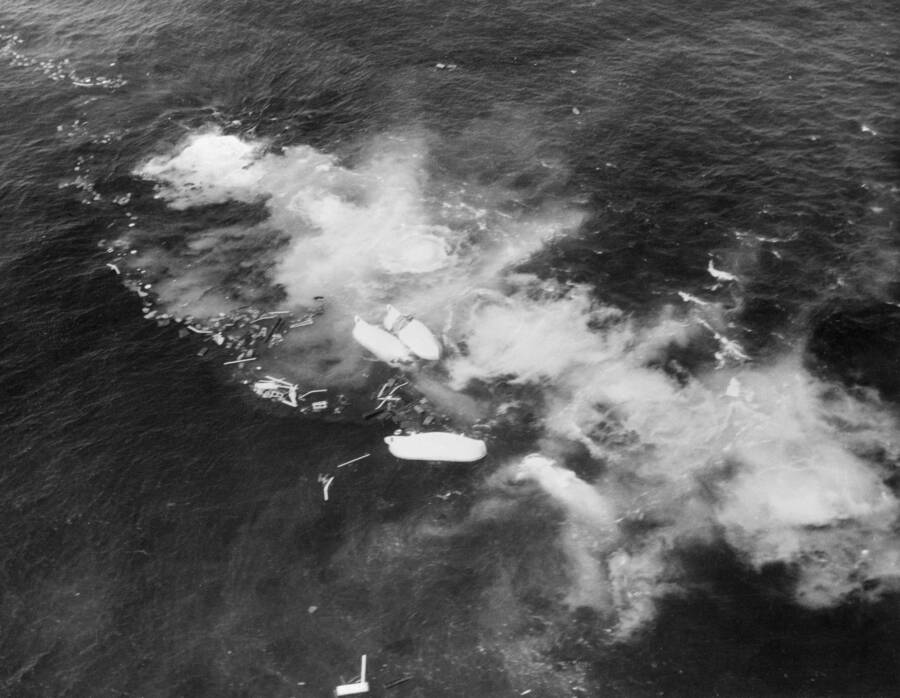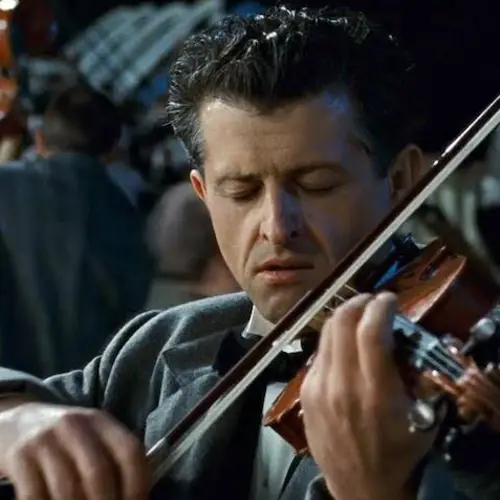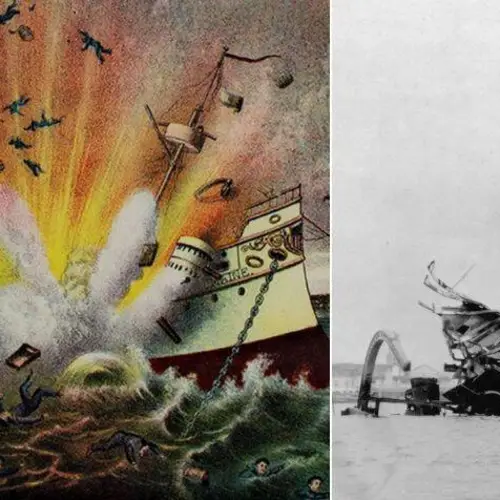The 1956 collision between the SS Andrea Doria and the MS Stockholm near Nantucket left 51 people dead and led to one of history’s largest civilian rescues at sea.
What it lacked in speed and size, the SS Andrea Doria made up for in beauty. Often called a “floating art gallery,” the luxury liner contained a multitude of paintings, tapestries, and murals — in addition to its three on-deck swimming pools.
The Andrea Doria wasn’t all style over substance, however. It boasted several notable safety features including a hull divided into 11 watertight compartments and two radar screens, which was still fairly new technology for the time.
Captained by a veteran of both World Wars, Piero Calamai, the Andrea Doria set out on its maiden voyage from Genoa, Italy to New York City on Jan. 14, 1953 and proved to be immensely popular, successfully completing 100 Atlantic crossings over the course of the next three years.
But on July 17, 1956, the Andrea Doria‘s 101st trip would end up being its last. The Andrea Doria collided with a Swedish vessel, the MS Stockholm as they crossed paths in the Atlantic. A combination of heavy fog and misjudged courses caused the Stockholm to barrel into the starboard side of the Andrea Doria, tearing open several of its 11 watertight compartments.
51 people died as a result of the collision, but over 1,500 were saved in the subsequent rescue. Still, with so many successful journeys under its belt, a more than capable captain, and new radar technology, such a collision should have been easily avoided — so what happened?
The SS Andrea Doria And Post-War Italy
The years following World War II were a time of great change for the people of Italy, who had been trapped under the fascist rule of a disgraced and recently-executed Benito Mussolini.
Naturally, the Italian people were happy to be rid of their fascist dictator — as evidenced by the way his body was mutilated following his execution — but that still left the question of what came next. The general consensus was for a republic to replace the country’s monarchy, and in 1948, a new Italian constitution was drafted, and the Christian Democrats took over the governance of the country.
Then, in 1951, according to a timeline from the BBC, Italy joined the European Coal and Steel Community, a supranational conglomerate that sought to establish a common market for coal and steel across Europe and ideally expand the economy, increase employment, and promote a higher standard of living across regions that had been ravaged during the six years of the Second World War.
That same year, at the Ansaldo Shipyard in Genoa, the SS Andrea Doria made its debut, becoming the flagship of the Italian line and a source of national pride for the Italian people. The cutting-edge vessel was named for the Italian hero, Andrea Doria, an imperial admiral for what was once the Republic of Genoa at a time when the small commune faced constant threat from the Ottoman Empire.

Photo 12/Universal Images Group via Getty ImagesAndrea Doria (1468-1560), the Italian captain and namesake of the SS Andrea Doria.
Construction of the Andrea Doria cost a total of about $29 million — but it was apparently well worth the expense, as the Andrea Doria was widely regarded as a marvelously beautiful ship.
Its deck held three large swimming pools, and it boasted a series of specially commissioned art pieces that led many to refer to the ship as a “floating art gallery.”
By the time it was ready for its maiden voyage in 1953, transatlantic ocean liner travel was reaching its peak, and countless Italians and Americans boarded the Andrea Doria to discover the wonders of the world across the sea.
The Noble Maritime Collection describes life aboard the Andrea Doria as “a whirl of glamour and sophistication, with well-appointed staterooms, common areas adorned with fine art, and endless entertainment.”
In just three years, the Andrea Doria completed over 100 voyages across the Atlantic, but as fate would have it, its 101st ended in tragic disaster.
The Final, Fateful Voyage Of The SS Andrea Doria
On July 17, 1956, the Andrea Doria left Italy for its 101st transatlantic crossing with 1,134 passengers and 572 crew members on board. After stopping at three other ports in the Mediterranean, the Andrea Doria was ready to embark on another nine-day journey to New York City.
Around 10:45 p.m. on July 25, the Andrea Doria sailed across the waters just south of Nantucket. The Nantucket Lightship reported dense fog along the Eastern Seaboard that evening, but the Andrea Doria's radar system was able to detect an approaching vessel 17 nautical miles away.
As reported by HISTORY, the MS Stockholm, a Swedish passenger liner, had departed New York that same evening, heading back to its homeport in Gothenburg. Like the Andrea Doria, the Stockholm was equipped with radar technology — so each ship knew the other was heading their way.

Bettmann/Getty ImagesNew York's mayor Vincent Impellitteri (center) shakes the hand of Captain Piero Calamai after the Andrea Doria's maiden voyage.
Captain Piero Calamai of the Andrea Doria maintained a quick speed despite the heavy fog, determined to dock in New York in the early morning. Likewise, the Stockholm, under third officer Johan-Ernst Carstens-Johannsen's watch, was aiming to shorten its journey, and so the ship's path was much further north than the recommended eastbound route.
Still, each of the men was an experienced mariner, and another vessel approaching was nothing new. Unfortunately, one of them inadvertently misread the radar, and Carstens and Calamai emerged with different ideas of what should be done. Intending to keep the Andrea Doria to his left, Carstens prepared for a port-to-port passing, the standard "rules of the road" for two passing vessels.
For some reason, Calamai intended to keep the Stockholm positioned to his right, and prepared for a starboard-to-starboard passing — meaning the ships were now steering toward each other. Neither officer realized this fact, however, until just before 11:10 p.m., when the Stockholm's lights broke through the dense fog and an officer aboard the Andrea Doria screamed, "She's coming right at us!"
The Andrea Doria And Stockholm Collide
Calamai instructed the officers to make a hard left turn; Carstens attempted to slow the Stockholm by reversing its propellors. Neither maneuver worked, and the Stockholm's reinforced steel bow, meant to break through icy waters in the North Atlantic, crashed into the Andrea Doria's starboard side, penetrating 30 feet into its hull.
A moment later, the Stockholm's bow dislodged from the side of the Andrea Doria, leaving a massive hole in its place.
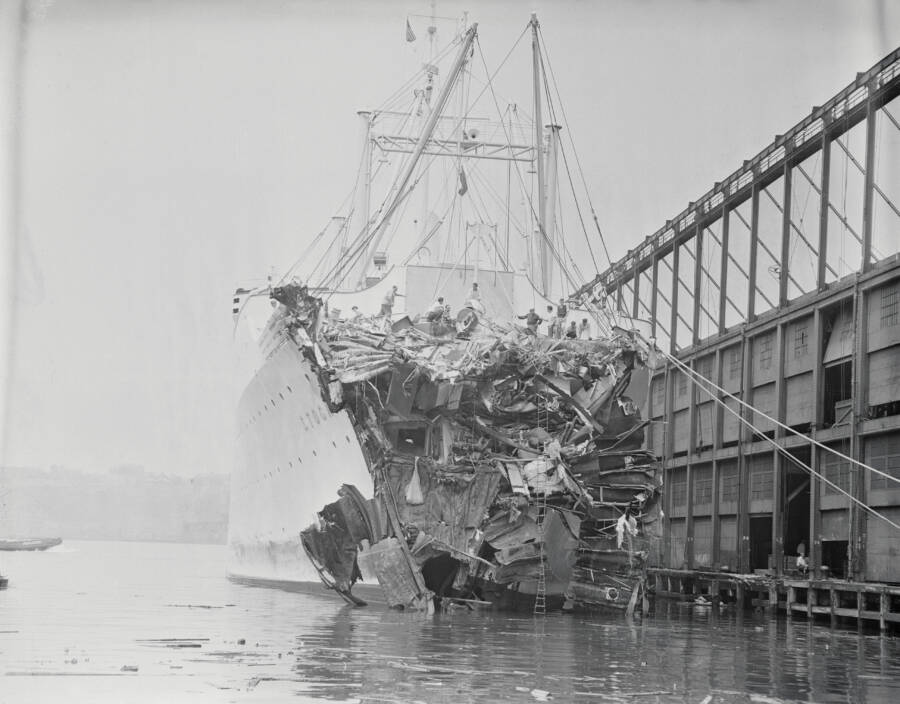
Bettmann/Getty ImagesThe mangled bow of the MS Stockholm after its collision with the Andrea Doria.
The collision killed five people aboard the Stockholm and 46 on the Andrea Doria.
In one cabin, an Italian immigrant named Maria Sergio had been sleeping with her four children when the Stockholm's bow tore into the Doria's side, killing them instantly. Elsewhere, a Brooklynite named Walter Carlin was in his cabin with his wife when the exterior wall of their room was ripped away — and his wife with it.
Another passenger, Linda Morgan, was sleeping in a side cabin at the time of the collision. The Stockholm's bow burst into the cabin, killed Morgan's stepfather and stepsister, but did not kill Morgan. Instead, she found herself launched onto the bow, breaking nothing more than her arm in the process.
"I was on the Andrea Doria," she said to the crew member who found her. "Where am I now?"
The Rescue Of The Andrea Doria's Passengers Became The First Major Event To Be Covered In Real Time By The Media
Almost immediately after the collision, the Doria began to list toward its starboard side. Seawater rushed into its watertight compartments.
Knowing the ship would not survive, Captain Calamai made the call to abandon ship, but now a new problem surfaced: The severity of the ship's list meant that the eight lifeboats on the port side couldn't launch.
With the lifeboats they could access still, the ship's crew would only be able to transport 1,000 passengers.
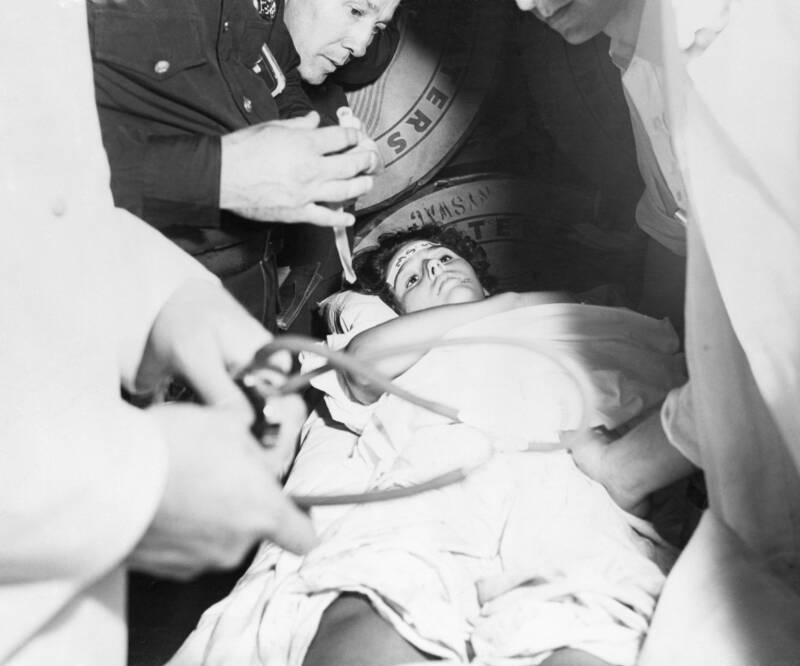
Bettmann/Getty ImagesLinda Morgan being carried away on a stretcher after the Stockholm safely reached land.
And though the Stockholm was still seaworthy, there was no way to transfer every person on the Doria to the other vessel. But they were in a frequently traveled region of the Atlantic, and not far from the shore. The Andrea Doria radioed for help: "Here danger immediate. Need lifeboats — as many as possible — can't use our lifeboats."
News of the sinking ship quickly reached land, and its close proximity to the shore allowed reporters and photographers to capture the rescue in real time, an unprecedented moment in American news history — and one of the largest maritime rescues ever made during peacetime.
Two nearby vessels were able to quickly reach the sinking ocean liner: A freighter, the Cape Ann, took 129 of the surviving passengers, and a U.S. Navy ship, the Pvt. William H. Thomas, took 159. The Stockholm, after it was declared seaworthy, took 545.
Then, finally, a massive French liner, the Ile de France, came to the Doria's aid, taking the remaining 753 passengers. For a time, the Doria remained afloat, threatening to capsize at any moment — but that moment didn't come until 10:09 a.m., roughly 11 hours after the fateful collision.
Now, the Andrea Doria sits at the bottom of the Atlantic Ocean at a depth of roughly 250 feet, with many divers visiting the sunken ship, referring to it as the "Mount Everest" of shipwreck dives. Yet it seems the tragedy of the Andrea Doria did not end with the ship's sinking, as over a dozen divers have died while exploring the ship's watery grave.
After this dive into the tragedy of the SS Andrea Doria, learn about the wreck of the Andrea Gail and the "perfect storm" that caused it. Also read about the sinking of the USS Indianapolis that became a frenzy for hungry sharks.
